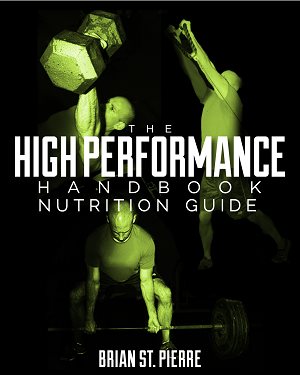Filed under: General Health, Nutrition, Recipes
I have returned from my honeymoon and I am ready to get back to dishing out some good content. Hope you all enjoyed your long weekend as much as I did. Here we go.
At Cressey Performance (the website is being overhauled, just a little fyi) I do a lot of in-person nutrition consults. Though I would say the majority of my clientele are high school athletes, followed by the pro guys, not too far behind are just regular 9-5ers. Contrary to popular belief, places like CP and Boyle’s actually train a lot of “regular” people, we do not exclusively train athletes.

Not the world's healthiest chicken
While doing a nutrition consultation with one of our “regular” clients I came across a pretty neat idea. I was looking over his food log and he noted that he had breaded chicken for dinner. I made a mental note to possibly comment on that, depending on how he went about his breading process. I continued to read and what he did was absolutely brilliant.
As most of you know I am not a huge fan of wheat. I think some is ok, but people tend to consume to much of it, even the whole kind. It’s high gluten content could possibly be problematic for people, even if they don’t have celiacs.
He breaded his chicken cutlets with dry quinoa and shredded unsweeted coconut. Absolutely awesome. He then baked it in a pyrex dish at about 400 degrees for 10-15 minutes. This is absolutely awesome. It provided some extra texture, favor, fiber and healthy fats.
After talking with yet another adult client last night who is very up on his nutrition, we came up with the idea of using quinoa flakes, as it would probably be even easier and maybe a little tastier for the breading.

Basically you would just purchase some chicken breasts, cutlets, tenders what have you (ideally pasture raised, but do the best you can within your budget). Dip into a bowl with a whipped up egg (again ideally pasture-raised), then take the lightly egg-covered chicken and press into a bowl with a mixture of the organic quinoa flakes, and some organic unsweetened shredded coconut. Cook as many as you want/need, bake in a covered pyrex at 400 for as long as needed, depending on the thickness of the chicken. Enjoy!
<a title=”Breading on Foodista” href=”http://www.foodista.com/technique/482ZKJDV/breading”><img alt=”Breading on Foodista” src=”http://dyn.foodista.com/content/embed/b2_482ZKJDV_9808a6b105533742df30e45e1e5ff334c8d7d00c.png?foodista_widget_4XTN68D8″ style=”border:none;width:300px;height:175px;” /></a>
Filed under: General Health, Nutrition, Recipes
The title says it all. This is one delicious dessert, and can even be used in place of morning oatmeal, and it is absolutely delicious. This is my fiance’s recipe that we have continually modified to make ever healthier, and it gets better every time!
Let’s not waste any more time, here it is:
Blueberry Apple Crisp

Apple Mix
- 4 Gala apples – cored and sliced
- 1 tbsp lemon or orange juice
- 1-1.5 tsp cinnamon
Blueberries
- 1 cup fresh or frozen wild blueberries

Topping
- 1 cup old fashioned oats
- 1/3 cup buckwheat flour
- 2 tbsp brown sugar
- 4 tsp extra virgin olive oil
- 1 tbsp lemon or orange juice
- 1/2 tsp cinnamon
Directions
- Spray a 9×9 pyrex pan with 1 tsp extra virgin olive oil (I like the Misto sprayer).
- Stir the Apple Mix until evenly distributed, and then place in the pan.
- Sprinkle the blueberries on top.
- Cover with the Topping, evenly distributing.
- Bake in pre-heated oven at 350-375 degrees for about 35-40 minutes or until apples are tender and topping is browned.
- Enjoy hot or cold.
- Optional – you can sprinkle in some milled flax for extra fiber if desired or some raw chocolate nibs, maybe add in some unsweetened shredded coconut, the possibilities are endless!
Filed under: General Health, Nutrition, Recipes
Tuna seems to be a food that falls on two opposite ends of the spectrum. Some people eat it like it is going out of style, while some avoid it like the plague. Tuna is a great source of protein, the cancer-fighting selenium, vitamin B-12, with some omega-3 fats. These are the benefits of tuna. The downside is that it contains a fair amount of mercury, depending on the type.
The two real options are white tuna, and light tuna. Though there are variations of each, these are the two main differences. White tuna comes from albacore tuna, a large species with a fair amount of mercury.

Light tuna usually comes from skipjack tuna, a smaller species with significantly less mercury content. Though a small amount of light tuna also comes from yellowfin tuna, which has roughly equal mercury content to that of albacore.
The albacore has a higher fat content and therefore more omega-3′s and fat-soluble vitamins, but I would say this is off-set a bit by the higher mercury content. For adults 1-2 cans of albacore per week is completely acceptable and well below the risk area of mercury issues. For pregnant women and children, please refer to this stance of the FDA. While I do think the FDA is very conservative in their advice, you can obtain all the nutrients in tuna with less risk than eating more than 1-2 cans of albacore per week.
Light tuna has a significantly lower fat content, meaning only small amounts of omega-3′s, while also only having about 1/3 of the mercury content on average (unless from yellowfin). Light tuna can be eaten more often than albacore due to its lower mercury content, so 3-4 cans per week should not be a problem whatsoever.

The last conundrum with tuna is that white tuna tastes so much better than light. I usually suggest using an organic, canola oil based mayo (preferably the canola oil being cold pressed) or a mayo made from extra virgin olive oil. You can even make your own mayo, with this recipe that I really like:
- 1 omega-3 or pastured egg
- 1 tablespoon lemon juice
- 2 teaspoons Dijon mustard
- Redmond Real Salt and freshly cracked black pepper
- 1 cup extra virgin olive oil
I hope that helps clear up some of the confusion surrounding tuna safety, intake, and the best choice to make.
Filed under: Nutrition, Recipes
My fiance and I were perusing through Gourmet Nutrition the other day and came across the Banana Nut Squares. We hadn’t tried these yet, they looked delicious and we happened to have 3 bananas getting pretty ripe sitting in our fruit bowl. So we set about making some for the week.
Since we had 3 very ripe bananas, we had to double the recipe. This was fine with me because it gave me more wiggle room to modify it to my liking! The recipe (doubled) called for 4 cups of walnut meal. I love walnuts and all, but that seemed a bit over the top. So we got creative. I am more of a little of this, a little of that kind of cook, so we didn’t actually measure everything else we added, we just made sure it came out to about 4 cups total. We used roughly 3 cups of walnut meal, maybe a little less. The last cup was made up of chia seeds, milled flax, and unsweetened shredded coconut. This gave us a little more fiber, an increase in omega-3′s, less omega-6′s and a little healthy dose of saturated fat to top it off. Needless to say, they came out awesome.
Here is the recipe, modified BSP style:
Banana Nut Protein Bars
- Banana, very ripe and mashed – 1/2 cup
- Whole omega-3 (or pastured) eggs – 2
- Cottage Cheese – 1/4 cup
- Rolled oats – 1/2 cup
- Walnut meal – 1 1/2 cup
- Milled flax seed – 2 tbsp
- Chia seeds – 2 tbsp
- Unsweetened shredded coconut – 1/4 cup
- Vanilla whey/casein protein blend – 6 scoops
- Vanilla extract – a touch (we didn’t measure)
- Baking soda – 1/4 tsp
- Redmond Real Salt – 1/8 tsp
- Extra Virgin Olive Oil Spray (from the Misto sprayer)
Pre heat your oven to 350 degrees. Whisk the eggs and combine with the banana, cottage cheese and vanilla extract. Combine all dry ingredients and stir until mixed. Slowly add wet ingredients to dry and combine until well mixed. Be patient, it takes a while. Lightly coat a 9×9 pan with the olive oil. Bake for 10-15 minutes. Really make sure to not overcook as they will dry out. This makes 4 large or 8 small servings. Enjoy!
For more great meal and snack ideas like this, check our Dr. Berardi’s incredible Gourmet Nutrition 2.0.

Filed under: General Health, Nutrition, Recipes
I am reviving an old formula for today’s blog, posting a delicious and healthy recipe. A while back I blogged about some of my favorite condiments, one of them being hummus. As most of you probably know, baby carrots and hummus is one of my absolute favorite snacks (along with some protein!).
Because of this love with hummus one of our CP clients, who is an amazing cook, gave me her home-made hummus recipe that I am going to share here with you guys. Thank you Nancy!
Without further ado:
Tuscan Hummus
- 1 large can chick peas
- Juice of 1 lemon
- 2 tbsp extra virgin olive oil
- salt and pepper to taste (lots of pepper)
- pinch of fresh garlic
- 1 cayenne pepper
- 1 bunch of steamed Tuscan kale
Add some water to blend, add slowly to emulsify and get the correct consistency.
Steam the kale, let it cool and squeeze out the liquid.
Puree all ingredients in a blender and season to taste. Add water very slowly to get correct consistency.
Allow to sit overnight and enjoy!









Posted on October 16th, 2009 by Brian St. Pierre
7 Comments »